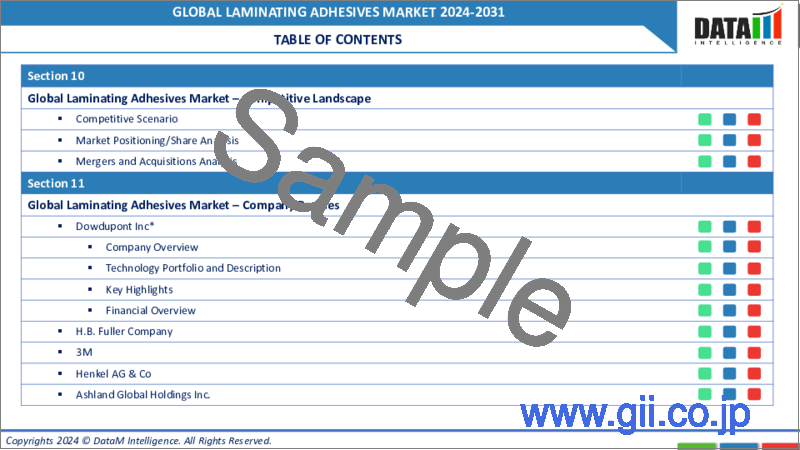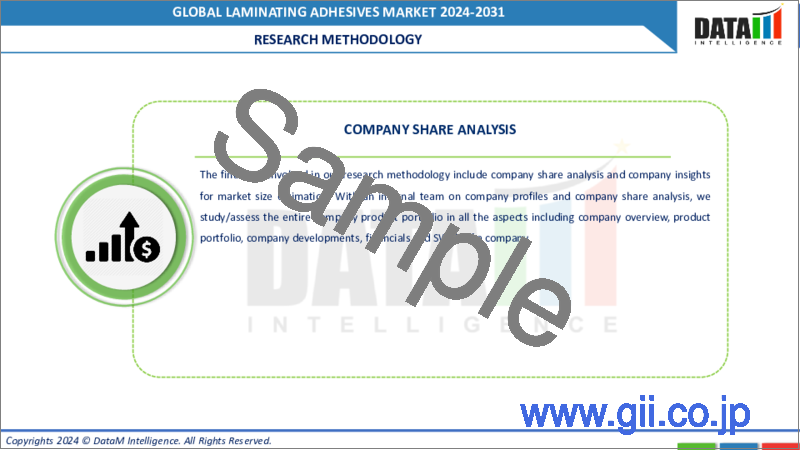|
|
市場調査レポート
商品コード
1290415
ラミネート接着剤の世界市場-2023-2030Global Laminating Adhesives Market - 2023-2030 |
||||||
|
● お客様のご希望に応じて、既存データの加工や未掲載情報(例:国別セグメント)の追加などの対応が可能です。 詳細はお問い合わせください。 |
|||||||
| ラミネート接着剤の世界市場-2023-2030 |
|
出版日: 2023年06月12日
発行: DataM Intelligence
ページ情報: 英文 185 Pages
納期: 約2営業日
|
- 全表示
- 概要
- 目次
市場概要
ラミネート接着剤の世界市場は、2022年に32億米ドルに達し、2023年から2030年の予測期間中に5.5%のCAGRで成長し、2030年には49億米ドルに達すると予測されています。
世界のeコマース産業の成長は、今後数年間、世界のラミネート接着剤市場の成長を促進します。安全な包装材はeコマース産業にとって重要であり、さらに、バーコードラベルのような追跡可能なソリューションの使用増加もラミネート接着剤の需要を増大させるでしょう。
アジア太平洋地域は今後数年間で主要な需要源となることが予想されるため、主要な市場関係者はアジア太平洋地域での生産を増やしています。例えば、2022年9月、日本のインク、接着剤、シーラントのメーカーである東洋インキは、将来の需要を見込んで、アジアにおけるラミネート接着剤の生産能力を倍増すると発表しました。
市場力学
電気自動車の普及が進む
電気自動車(EV)の普及は、価格の低下と技術的な改善により、従来の自動車に代わる環境に優しい現実的な選択肢として、近年大幅に増加しています。国際エネルギー機関(IEA)のデータによると、2022年には世界で1,000万台以上の電気自動車が販売され、2023年には35%増の約1,400万台が販売されると予測されています。
ラミネート接着剤は、電気自動車のさまざまな部品の接着や密封に重要な役割を果たします。この接着剤は、バッテリーセルの接着、パワーエレクトロニクスの組み立て、モーターや発電機の封止、内装トリムの接着などの用途で使用されています。ナットやボルトなどの機械的な接着の代わりにラミネート接着剤を使用することで、車両の重量を大幅に削減し、航続距離や性能を伸ばすことができます。
接着剤配合の技術的進歩
接着剤技術の進歩により、高性能なラミネート接着剤が開発されています。接着強度の向上、柔軟性の向上、耐熱性の向上、耐久性の向上など、より優れた特性を持つ接着剤です。従来の接着剤は、硬化に時間がかかるため、生産サイクルが長くなっていました。しかし、技術の進歩により、より硬化時間の短いラミネート接着剤が開発されました。
さらに、無溶剤の接着剤を経済的な価格で商業的に生産することも可能になりました。2022年9月、日本のラミネート接着剤メーカーである東洋モートン株式会社は、無溶剤ラミネート接着剤のECOADシリーズを発売しました。接着剤処方の進歩は、接着剤の新しいアプリケーションの開発につながり、世界市場の成長を促進します。
原材料価格の変動
樹脂、溶剤、添加剤など、ラミネート接着剤に使用される原材料は、世界市場において価格変動の影響を受けています。需給バランスの崩れ、地政学的緊張、自然災害などの要因によって、突然の価格高騰や供給不足が起こることがあります。価格の高騰は、製造業者の生産コストを上昇させ、利益率に影響を及ぼします。生産者は一般に、コスト上昇分を最終消費者に転嫁します。
原材料価格の変動は、メーカーがラミネート接着剤の価格設定を予測し安定させることを困難にしています。この不確実性は、メーカーとエンドユーザーの双方にとって、プロジェクトの予算編成、計画、実行に困難をもたらす可能性があります。このため、長期的な高額設備投資が遅れる可能性があり、世界市場の成長にとって不利になることが証明されています。
COVID-19の影響分析
COVID-19の大流行により、様々な産業でラミネート接着剤の需要が変動することになりました。自動車、エレクトロニクス、建設など特定の分野では、活動の縮小やプロジェクトの延期により、需要が大幅に減少しました。しかし、包装、医療、医薬品などの業界では、衛生的な食品包装、医療機器、個人用保護具(PPE)などの用途でラミネート接着剤の需要増が見られました。
パンデミック後、さまざまな産業で力強い回復が見られ、それがラミネート接着剤への需要向上につながっています。また、健康・衛生意識の高まりから、無菌医療機器メーカーの需要は短期的には高水準で推移すると思われます。
ウクライナ・ロシア紛争による影響
ロシア・ウクライナ紛争は、欧州のラミネート接着剤需要に大きな影響を及ぼしています。この戦争により、ウクライナの産業は完全に崩壊し、接着剤の需要も完全にストップしています。さらに、米国とEUがロシアに課した厳しい経済制裁により、ロシアの産業界へのラミネート接着剤の供給が途絶えました。
ロシアに進出していた欧米の接着剤メーカーの多くが事業を停止して撤退し、欧米の特殊接着剤の輸入も制裁のためにストップしています。この紛争により、ロシアの産業界は、主に中国やインドなどのアジア諸国を拠点とする代替サプライヤーからラミネート接着剤を調達することを余儀なくされています。
目次
第1章 調査手法とスコープ
- 調査手法
- 調査目的および調査範囲
第2章 定義と概要
第3章 エグゼクティブサマリー
第4章 市場力学
- 影響要因
- 促進要因
- 新興国におけるF&B産業の拡大
- 医療機器技術の進歩
- 電気自動車の普及拡大
- 粘着剤製剤の技術的進歩
- 抑制要因
- 持続可能な代替材料の入手が困難
- 原材料価格の変動
- 機会
- 影響分析
- 促進要因
第5章 産業分析
- ポーターのファイブフォース分析
- サプライチェーン分析
- 価格分析
- 法規制の分析
第6章 COVID-19の分析
第7章 タイプ別
- 溶剤
- 水性
- 無溶剤タイプ
- その他
第8章 エンドユーザー別
- パッケージング
- 飲食品
- 医薬品
- 消費財
- 産業
- 断熱材
- ウィンドウフィルム
- エレクトロニクス
- その他
- 自動車・輸送機器
- その他
第9章 地域別
- 北米
- 米国
- カナダ
- メキシコ
- 欧州
- ドイツ
- 英国
- フランス
- イタリア
- スペイン
- その他欧州
- 南米
- ブラジル
- アルゼンチン
- その他南米地域
- アジア太平洋地域
- 中国
- インド
- 日本
- オーストラリア
- その他アジア太平洋地域
- 中東・アフリカ地域
第10章 競合情勢
- 競合シナリオ
- 市況/シェア分析
- M&A(合併・買収)分析
第11章 企業プロファイル
- Dow
- 会社概要
- 製品ポートフォリオと概要
- 財務概要
- 最近の動向
- H.B. Fuller Company
- 3M
- Henkel AG & Co. KGaA
- Ashland
- Arkema
- DIC Corporation
- Flint Group
- Coim Group
- Vimasco Corporation
第12章 付録
Market Overview
The Global Laminating Adhesives Market reached US$ 3.2 billion in 2022 and is expected to reach US$ 4.9 billion by 2030, growing with a CAGR of 5.5% during the forecast period 2023-2030.
The growth of the global e-commerce industry will propel the growth of the global laminating adhesives market in the coming years. Secure packaging materials are critical for the e-commerce industry, furthermore, increasing usage of tracebility solutions such as barcoded labels will also augment demand for laminating adhesives.
Major market players are increasing production in Asia-Pacific, as the region is expected to the major source of demand in the coming years. For instance, in September 2022, Toyo Ink, a Japanese producer of inks, adhesives and sealants, announced that it was doubling its laminating adhesives production capacity in Asia in anticipation of future demand.
Market Dynamics
Increasing Adoption of Electric Vehicles
Electric vehicle (EV) adoption has increased significanty in recent years, as falling prices and technological improvements make it a viable eco-friendly alternative to conventional vehicles. Data from the international energy agency (IEA) suggests that more than 10 million electric vehicles were sold globally in 2022, with the agency forecasting that sales could increase by 35% to around 14 million in 2023.
Laminating adhesives play a crucial role in bonding and sealing various components in electric vehicles. The adhesives are used in applications such as battery cell bonding, power electronics assembly, motor and generator encapsulation and interior trim bonding. Using laminating adhesives instead of mechanical bonding such as nuts and bolts, greatly reduces vehicle weight, extending range and performance.
Technological Advancements in Adhesive Formulations
New advancements in adhesive technology has led to the development of high-performance laminating adhesives. The adhesives offer enhanced properties such as superior adhesion strength, improved flexibility, increased heat resistance and better durability. Traditional adhesives often require lengthy curing processes, leading to longer production cycles. However, technological advancements have resulted in the development of laminating adhesives with faster curing times.
Furthermore, new advancements have made it possible to produce solvent-free adhesives at economical prices on a commercial scale. In September 2022, Toyo-Morton, Ltd., a Japanese manufacturer of laminating adhesives, launched its ECOAD range of solvent-free laminating adhesives. Advances in adhesive formulation will lead to the development of new applications for adhesives, thus driving the growth of the global market.
Volatility in Raw Material Prices
Raw materials used in laminating adhesives, such as resins, solvents and additives, are subject to price fluctuations in the global market. Factors like supply-demand imbalances, geopolitical tensions and natural disasters can cause sudden price spikes or shortages. High prices can increase production costs for manufacturers, thus impacting their profit margins. Producers generally pass on the cost increase to end-users.
The volatility in raw material prices makes it challenging for manufacturers to predict and stabilize the pricing of laminating adhesives. The uncertainty can create challenges for both manufacturers and end-users in budgeting, planning and executing projects. It can potentially delay long-term high capital investments, thereby proving detrimental to the growth of the global market.
COVID-19 Impact Analysis
The COVID-19 pandemic resulted in fluctuating demand for laminating adhesives across various industries. Certain sectors, such as automotive, electronics and constructions, experienced significant declines in demand due to reduced activities and project postponements. OHowever, industries such as packaging, medical and pharmaceuticals witnessed increased demand for laminating adhesives for applications like hygienic food packaging, medical devices and personal protective equipment (PPE).
The post-pandemic period has witnessed strong recovery in various industries, which in turn has led to improved demand for laminating adhesives. Furthermore, with increased health and hygiene conciousness, demand from sterile healthcare equipment manufacturers is likely to remain elevated in the short-term.
Ukraine-Russia War Impact
The Russia-Ukraine conflict has significantly impacted the demand for laminating adhesives in Europe. The war has totally upended Ukraine's industry, thus completely stopping demand for adhesives. Furthermore, the severe economic sanctions imposed on Russia by U.S. and EU has disrupted the supply of laminating adhesives to Russian industries.
Many western adhesive manufacturers in Russia ceased operations and exited the country, whereas western imports of specialized adhesives were halted due to sanctions. The conflict has forced Russian industries to source laminating adhesives from alternative suppliers, mainly those based in Asian countries such as China and India.
Segment Analysis
The global laminating adhesives market is segmented based on type, end-user and region.
Versatility and Safety Ensure Widespread Adoption of Water-based Laminating Adhesives
Differential pressure meters are relatively simple in design, consisting of a primary element, such as an orifice plate and a differential pressure transmitter. Water-based adhesives offer good adhesion to a wide range of substrates, including films, foils, papers and textiles. Water-based adhesives are more economical than solvent-based adhesives and also have faster curing times, thus ensuring shorter production cycles.
Water-based laminating adhesives comply with stringent regulatory requirements imposed by government agencies and industry standards. The adhesives meet various global regulations, including restrictions on hazardous substances such as REACH regulations of the European Union (EU) and USFDA regulations for food contact materials.
Geographical Analysis
New Innovations and Product Launches Will Augment Market Growth in North America
North America is expected to occupy nearly a quarter of the global laminating adhesives market. North America has a high-income consumerist society. Various industries such as food and beverage, quick service restaurants (QSR) and consumer goods producers are constantly launching new products to maintain their market position and drive growth. Each new product launch generates a short-term rise in demand for laminating adhesives for packaging applications.
The automotive industry of North America is currently engaged in expanding the production of electric vehicles (EVs) due to favorable government policies and rising consumer demand. Automakers are launching new EV models and also undertaking research to innovate new technologies. Laminating adhesives are extensively used in the EV production process to securely fit various components and sub-assemblies.
Competitive Landscape
The major global players include: Dow, H.B. Fuller Company, 3M, Henkel AG & Co. KGaA, Ashland, Arkema, DIC Corporation, Flint Group, Coim Group and Vimasco Corporation.
Why Purchase the Report?
- To visualize the global laminating adhesives market segmentation based on type, end-user and region, as well as understand key commercial assets and players.
- Identify commercial opportunities by analyzing trends and co-development.
- Excel data sheet with numerous data points of laminating adhesives market-level with all segments.
- PDF report consists of a comprehensive analysis after exhaustive qualitative interviews and an in-depth study.
- Type mapping available as Excel consisting of key products of all the major players.
The global laminating adhesives market report would provide approximately 50 tables, 49 figures and 185 pages.
Target Audience 2023
- Consumer Electronics Manufacturers
- Automotive Manufacturers
- Packaging Manufacturers
- Industry Investors/Investment Bankers
- Research Professionals
- Emerging Companies
Table of Contents
1. Methodology and Scope
- 1.1. Research Methodology
- 1.2. Research Objective and Scope of the Report
2. Definition and Overview
3. Executive Summary
- 3.1. Snippet by Type
- 3.2. Snippet by End-User
- 3.3. Snippet by Region
4. Dynamics
- 4.1. Impacting Factors
- 4.1.1. Drivers
- 4.1.1.1. Expansion of F&B Industry in Emerging Economies
- 4.1.1.2. Advances in Medical Device Technology
- 4.1.1.3. Increasing Adoption of Electric Vehicles
- 4.1.1.4. Technological Advancements in Adhesive Formulations
- 4.1.2. Restraints
- 4.1.2.1. Limited Availability of Sustainable Alternatives
- 4.1.2.2. Volatility in Raw Material Prices
- 4.1.3. Opportunity
- 4.1.4. Impact Analysis
- 4.1.1. Drivers
5. Industry Analysis
- 5.1. Porter's Five Force Analysis
- 5.2. Supply Chain Analysis
- 5.3. Pricing Analysis
- 5.4. Regulatory Analysis
6. COVID-19 Analysis
- 6.1. Analysis of COVID-19
- 6.1.1. Scenario Before COVID
- 6.1.2. Scenario During COVID
- 6.1.3. Scenario Post COVID
- 6.2. Pricing Dynamics Amid COVID-19
- 6.3. Demand-Supply Spectrum
- 6.4. Government Initiatives Related to the Market During Pandemic
- 6.5. Manufacturers Strategic Initiatives
- 6.6. Conclusion
7. By Type
- 7.1. Introduction
- 7.1.1. Market Size Analysis and Y-o-Y Growth Analysis (%), By Type
- 7.1.2. Market Attractiveness Index, By Type
- 7.2. Solvent-Based*
- 7.2.1. Introduction
- 7.2.2. Market Size Analysis and Y-o-Y Growth Analysis (%)
- 7.3. Water-Based
- 7.4. Solventless
- 7.5. Others
8. By End-User
- 8.1. Introduction
- 8.1.1. Market Size Analysis and Y-o-Y Growth Analysis (%), By End-User
- 8.1.2. Market Attractiveness Index, By End-User
- 8.2. Packaging*
- 8.2.1. Introduction
- 8.2.2. Market Size Analysis and Y-o-Y Growth Analysis (%)
- 8.2.3. Food & Beverage
- 8.2.4. Pharmaceuticals
- 8.2.5. Consumer Products
- 8.3. Industrial
- 8.3.1. Insulation
- 8.3.2. Window Films
- 8.3.3. Electronics
- 8.3.4. Other Applications
- 8.4. Automotive & Transportation
- 8.5. Others
9. By Region
- 9.1. Introduction
- 9.1.1. Market Size Analysis and Y-o-Y Growth Analysis (%), By Region
- 9.1.2. Market Attractiveness Index, By Region
- 9.2. North America
- 9.2.1. Introduction
- 9.2.2. Key Region-Specific Dynamics
- 9.2.3. Market Size Analysis and Y-o-Y Growth Analysis (%), By Type
- 9.2.4. Market Size Analysis and Y-o-Y Growth Analysis (%), By End-User
- 9.2.5. Market Size Analysis and Y-o-Y Growth Analysis (%), By Country
- 9.2.5.1. The U.S.
- 9.2.5.2. Canada
- 9.2.5.3. Mexico
- 9.3. Europe
- 9.3.1. Introduction
- 9.3.2. Key Region-Specific Dynamics
- 9.3.3. Market Size Analysis and Y-o-Y Growth Analysis (%), By Type
- 9.3.4. Market Size Analysis and Y-o-Y Growth Analysis (%), By End-User
- 9.3.5. Market Size Analysis and Y-o-Y Growth Analysis (%), By Country
- 9.3.5.1. Germany
- 9.3.5.2. The UK
- 9.3.5.3. France
- 9.3.5.4. Italy
- 9.3.5.5. Spain
- 9.3.5.6. Rest of Europe
- 9.4. South America
- 9.4.1. Introduction
- 9.4.2. Key Region-Specific Dynamics
- 9.4.3. Market Size Analysis and Y-o-Y Growth Analysis (%), By Type
- 9.4.4. Market Size Analysis and Y-o-Y Growth Analysis (%), By End-User
- 9.4.5. Market Size Analysis and Y-o-Y Growth Analysis (%), By Country
- 9.4.5.1. Brazil
- 9.4.5.2. Argentina
- 9.4.5.3. Rest of South America
- 9.5. Asia-Pacific
- 9.5.1. Introduction
- 9.5.2. Key Region-Specific Dynamics
- 9.5.3. Market Size Analysis and Y-o-Y Growth Analysis (%), By Type
- 9.5.4. Market Size Analysis and Y-o-Y Growth Analysis (%), By End-User
- 9.5.5. Market Size Analysis and Y-o-Y Growth Analysis (%), By Country
- 9.5.5.1. China
- 9.5.5.2. India
- 9.5.5.3. Japan
- 9.5.5.4. Australia
- 9.5.5.5. Rest of Asia-Pacific
- 9.6. Middle East and Africa
- 9.6.1. Introduction
- 9.6.2. Key Region-Specific Dynamics
- 9.6.3. Market Size Analysis and Y-o-Y Growth Analysis (%), By Type
- 9.6.4. Market Size Analysis and Y-o-Y Growth Analysis (%), By End-User
10. Competitive Landscape
- 10.1. Competitive Scenario
- 10.2. Market Positioning/Share Analysis
- 10.3. Mergers and Acquisitions Analysis
11. Company Profiles
- 11.1. Dow*
- 11.1.1. Company Overview
- 11.1.2. Type Portfolio and Description
- 11.1.3. Financial Overview
- 11.1.4. Recent Developments
- 11.2. H.B. Fuller Company
- 11.3. 3M
- 11.4. Henkel AG & Co. KGaA
- 11.5. Ashland
- 11.6. Arkema
- 11.7. DIC Corporation
- 11.8. Flint Group
- 11.9. Coim Group
- 11.10. Vimasco Corporation
LIST NOT EXHAUSTIVE
12. Appendix
- 12.1. About Us and Services
- 12.2. Contact Us




